Playing is an important aspect of every cat's life. It helps them learn and maintain their health and overall well-being. One of the health aspects where playing plays a major part is obesity. While your vet can help you design appropriate diet for your kitty, you can start stimulating them to exercise through play starting from today. Here are a few tips to help you learn how to play with your cat.

How to get started
First and foremost, avoid playing with your hands. You don't want to use your hands as prey because your cat may accidentally hurt you and you want them to associate your hands with food and petting, not killing. Furthermore, don't rattle your cat on their head or belly in order to engage them in play. While some cats may like this, most will be annoyed and may even become aggressive.
Thus, you should try to use various toys (bought or crafted) to play with instead. When trying to get your interested in a toy or game you provided them with, remember that they all love to hunt. Despite being well-fed, most cats retained their inner hunters through the evolution. For this reason, cat play almost always consists of hunting behavior simulations. And you can use this very well to encourage them to get started.
Find the right toys
To simulate a hunting behavior you will need a prey for your cat to hunt. The toy of your choice should be something that will intrigue your particular cat. Just like in nature, a cat can prefer different prey and applying different hunting techniques. Experiment with toys of different shape, size and color.
Toys with sound stimulation are also often effective. Find a few of your cat's favorite and alternate them to prevent boredom. Most popular cat toys out there are wand toys, catnip mice, balls and toys decorated with feathers and/or bells. The Spruce Pets created a list of their Top Picks for cat toys.

Design a game
Now that you have the "prey", the game can begin! The game will really depend on the toy of your choice. If you chose a toy that may resemble a small animal, then try to imitate an actual prey by sneaking and swinging the toy around. Make sure to be consistent and give your cat time to stalk or chase. After some time, and before your cat gets too bored, allow your cat to "catch" the prey. If your cat's hunt was successful, it is more likely for them to be interested in another game.
Other toys you may want to use to try and play fetch with your cat. For fetching, choose a toy you can throw but that would be of interest to your kitty. Then throw it and watch if your cat leaps to chase it. Try this several times and with several toys to see if your cat will be interested in chasing. Many times, cats actually successfully retrieve the toy.
If your cat doesn't seem to engage in any of the games you propose, don't get discouraged and keep trying until you find the way in which your cat likes to play. It is recommended to take the toy away after the game in order to prevent boredom. It will also be more realistic to a kitty if the toy goes away after the hunt. What kind of a prey never goes away?
Remember, your game doesn't even have to include fancy toys. If you catch a light with a watch or similar reflective item, your cat is likely to be interested in the reflection and may start chasing it. Many cat parents use laser pointers in a similar way when playing.
Furthermore, many cats also love the sound of crumpled paper, balls of wool or paper bags. Use your imagination and craft your own toys! Watch your cat and pay attention to its interest for inspiration. Oh, and not to forget, nowadays you can even download some games for your cat to your phone or tablet.

Always leave the game on a successful note.
In order to prevent your cat from losing interest in the games you play with them, make sure to always let them "catch" the prey before ending the game. The game shouldn't be too easy, but the cat should still be able to savor the taste of victory. If you used the reflective objects or laser pointers, end the game on a small object or toy which your cat can grab.

Find the purrfect timing
Cats are often most active early in the morning or in the late afternoon. But not all cats are the same. Try playing with your kitty at different times of day in order to find the periods when it's most active and playful. You should engage in several play sessions a day at the times that are convenient for both you and your kitty.
Provide your cat with opportunities for solo play
This is particularly important for cats who spend a lot of the time alone at home. Provide them with toys that they can play with on their own. These can be many different available toys, such as towers with balls to chase, systems of holes and tunnels with prey etc. The key here is to keep your cat's toys interesting. Cats often get bored by toys and they certainly love a good toy collection.
You don't have to buy a new toy every day though. Set only a few toys for solo game out and keep the rest hidden. Then every day, "present" your cat with a new toy and hide one old away. Keep rotating them and watch your cat never getting tired of its toy collection! Remember: If you are leaving your cat alone with the toy, make sure that it's safe enough that it doesn't need your supervision.

The more you engage in play with your kitty, the more you will learn from it. Observe your kitty's behavior and use it to improve the games. Playing is one of the best ways to get your cat to move and exercise. You will have fun, you will bond with your kitty and you will maintain its health – and all at once!
